The average American home now costs over half a million dollars, while tiny homes offer full functionality at just 9% of that price. These sub-500-square-foot structures have evolved from quirky novelties to mainstream housing alternatives, serving as primary residences, remote workstations, and vacation retreats.
Remote employment trends have particularly boosted their appeal. Many professionals now use tiny home designs to create dedicated office spaces separate from their main living areas. This separation helps maintain work-life balance while keeping utility costs low.
However, maintaining consistent temperatures in such compact environments presents unique challenges. Standard HVAC systems often prove impractical due to space limitations and energy inefficiency. Owners must balance airflow needs with square footage constraints while preventing moisture buildup.
This guide explores innovative approaches to temperature management in miniature dwellings. We’ll examine space-saving equipment options, ventilation strategies, and insulation methods tailored to small-scale architecture. Proper implementation helps reduce energy bills while creating livable conditions across all seasons.
Table of Contents
Key Takeaways
- Tiny homes cost 90% less than traditional houses while offering versatile living solutions
- Remote workers increasingly use compact structures as private office spaces
- Climate control challenges stem from limited square footage and airflow dynamics
- Customized HVAC systems prevent humidity issues and energy waste
- Strategic insulation boosts efficiency in small living environments
Understanding the Unique Challenges of Heating and Cooling in Tiny Homes
Climate control in compact dwellings requires rethinking conventional approaches. Unlike standard houses, tiny homes demand precision in system design due to their minimized footprint and layered functionality.
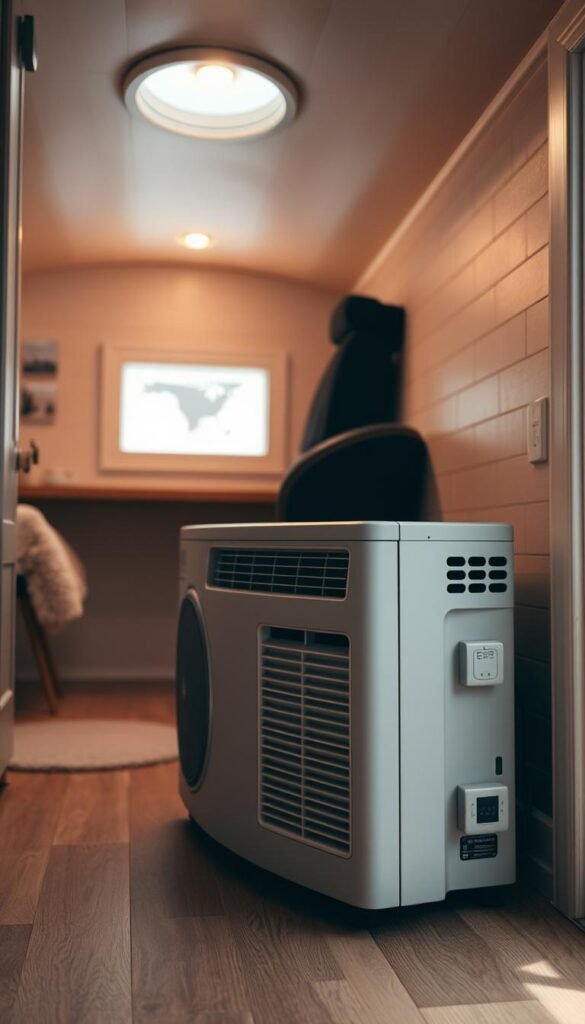
Space Limitations and Thermal Management
Traditional climate systems become impractical when square footage shrinks. Full-sized HVAC units occupy 15-20% of a tiny home’s floor area – space better used for living essentials. Owners frequently combine foldable furniture with vertical storage to preserve walkable zones.
Insulation often gets compromised when prioritizing electrical and plumbing layouts. Many compact dwellings leave minimal room for thermal barriers, causing rapid heat transfer through walls. This structural reality forces residents to seek alternative heating cooling solutions that compensate for energy leaks.
Airflow Dynamics in Confined Areas
Without duct networks, air circulation patterns become unpredictable. Portable units might cool one corner while leaving others stifling – a common frustration in tiny homes. Moisture accumulation exacerbates discomfort, particularly in humid climates.
Seasonal equipment storage adds another layer of complexity. Winter heaters and summer fans compete for precious storage real estate. Smart space utilization becomes critical, with some owners installing ceiling-mounted racks for off-season gear.
Comparing Tiny Home HVAC Requirements to Traditional Systems
Compact living spaces demand climate control solutions that defy conventional standards. Where traditional houses allocate entire rooms for mechanical equipment, tiny homes require precision-engineered alternatives that blend seamlessly into multi-functional areas.
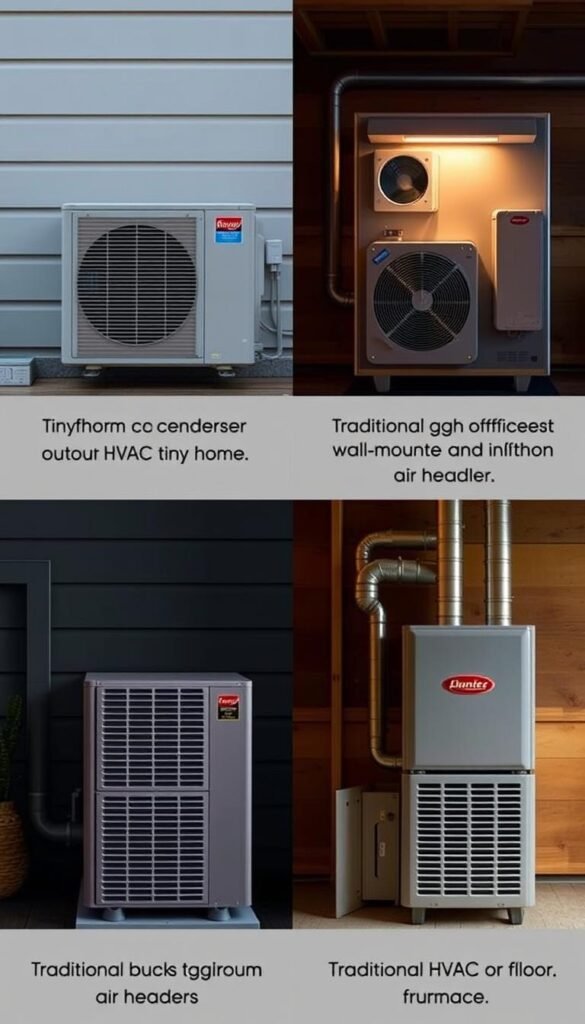
Space Efficiency and Creative Solutions
Standard traditional HVAC setups consume 300-500% more floor space than their compact counterparts. Basement furnaces and attic ductwork become impractical when square footage measures in single digits. Innovative owners now use vertical wall mounts and underfloor compartments to house heating cooling systems.
Ceiling-mounted mini-splits have emerged as popular choices, combining air handlers with decorative elements. Some designs integrate climate controls into fold-down furniture or staircase cavities. These adaptations preserve walkways while maintaining consistent temperature regulation.
Mobility and Installation Differences
Stationary tiny homes on foundations can utilize permanent outdoor units like ground-source heat pumps. Mobile versions require lightweight components that withstand road vibrations. Portable AC units with quick-connect fittings enable hassle-free relocation.
Utility connections highlight another contrast. Traditional houses use fixed electrical panels and gas lines, while mobile units often rely on solar-compatible systems or propane tanks. Maintenance access also varies – technicians might need to remove kitchen panels or lift bed platforms to service compact heating cooling equipment.
Tips for efficient heating and cooling in a tiny house
Selecting optimal temperature control systems requires balancing technical specs with spatial realities. Compact dwellings demand equipment that delivers year-round comfort without monopolizing limited square footage.
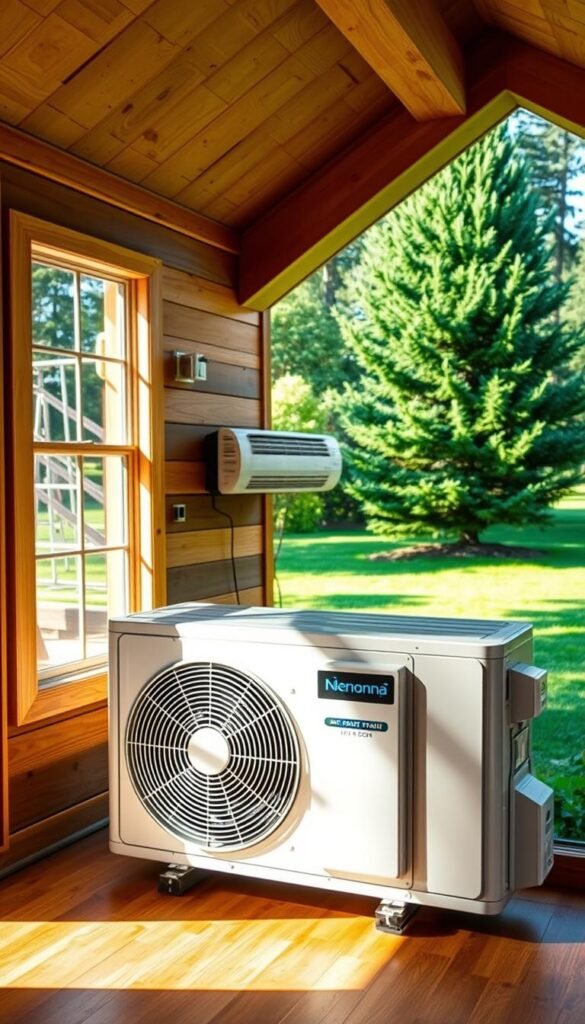
Choosing the Right HVAC System
Four factors dominate decision-making for tiny home climate systems:
| Factor | Cold Climates | Warm Climates | Mixed Zones |
|---|---|---|---|
| Ideal System | Ductless heat pumps | Mini-split AC | Multi-mode units |
| Space Needed | 2.5 sq ft | 1.8 sq ft | 3.1 sq ft |
| Noise Level | 45 dB | 50 dB | 48 dB |
Dual-purpose systems eliminate seasonal equipment swaps. Look for ENERGY STAR-rated models with inverter technology – they adjust output to maintain steady temperatures while cutting energy use by 30%.
Balancing Heat and Cool Performance
Proper sizing prevents temperature swings. Oversized units create rapid hot-cold cycles, while undersized models strain to maintain settings. Manual J load calculations ensure precise capacity matching.
Zoning strategies help distribute air evenly. Ceiling fans boost circulation without added HVAC strain. For mobile tiny homes, vibration-resistant mounting preserves system longevity during transport.
Consider decibel ratings carefully – whisper-quiet models below 50 dB prevent auditory fatigue in close quarters. Prioritize systems with easy-filter access to maintain airflow efficiency in dust-prone environments.
Exploring Ductless Mini-Split Systems for Tiny Homes

Ductless mini-split systems redefine climate control for compact living spaces. These units eliminate bulky ductwork while delivering precise temperature adjustments. Their modular design adapts to unique layouts common in tiny homes, making them ideal for mobile or stationary setups.
Benefits of the Mini-Split Design
Each system pairs discreet indoor units with a single outdoor compressor. Refrigerant lines and electrical wiring connect components through small wall openings. This setup preserves floor space and allows installation in areas where traditional cooling systems can’t operate.
Dual heating-cooling capabilities handle seasonal shifts effortlessly. Inverter technology adjusts power usage based on real-time needs, cutting energy waste by 25-30% compared to conventional models. Quiet operation below 50 decibels prevents disruptions in close quarters.
Zoning Options for Customized Comfort
Homeowners can create independent climate zones using multiple indoor units. Wall-mounted handlers work well in main living areas, while ceiling cassettes suit loft bedrooms. This zoning capability addresses temperature variations between elevated sleeping spaces and ground-level kitchens.
Multi-split configurations support up to four indoor units per outdoor compressor. Flexible placement options let residents direct airflow exactly where needed. For structures under 400 square feet, a single-zone system often provides sufficient coverage without sacrificing customization.
Alternative Heating and Cooling Options for Tiny Houses
Compact living demands creative climate solutions that adapt to spatial constraints. Owners often combine multiple approaches to maintain comfort without sacrificing precious square footage.
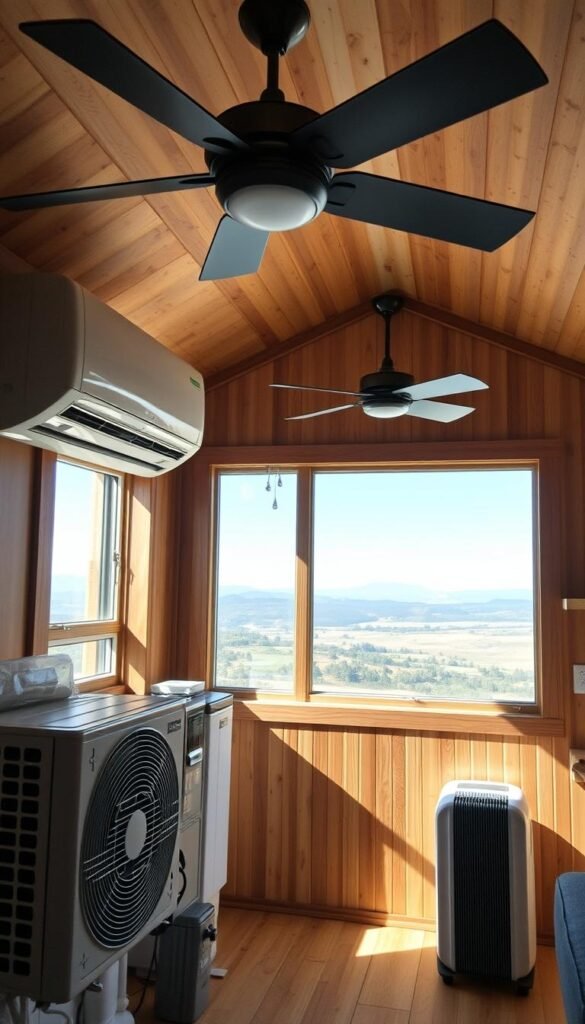
Portable Systems and Space Heaters
Portable AC units offer flexibility for mobile dwellings. These systems vent warm air through window-mounted hoses, requiring no permanent installation. Window units provide similar cooling at lower costs but may block natural light.
| Type | Best For | Pros | Cons |
|---|---|---|---|
| Portable AC | Temporary setups | No installation | Loud operation |
| Window AC | Fixed locations | Affordable | Blocks views |
| Space Heaters | Zone heating | Instant warmth | High energy use |
Electric heaters come in three primary styles. Oil-filled radiators maintain heat longest after shutdown. Ceramic models heat up quickly, while infrared units target specific areas effectively.
Ceiling Fans and Radiant Floor Heating
Reversible ceiling fans enhance both seasons’ comfort. Summer mode creates cooling breezes, while winter setting pushes warm air downward. This simple upgrade improves perceived temperature by 4-6°F.
Radiant floor systems eliminate visible equipment. Hydronic versions circulate heated water through subfloor pipes, while electric mats offer easier installation. Both types provide consistent warmth without occupying wall space.
- Operates silently
- Reduces dust circulation
- Works with most flooring types
Pellet stoves and electric fireplaces serve as supplemental heat sources. These options add visual appeal while providing backup warmth during extreme weather conditions.
Maximizing Energy Efficiency and Lowering Utility Bills
Smart technology transforms how compact dwellings manage temperature control. These innovations reduce energy consumption while maintaining comfort, proving particularly valuable in tiny homes where every watt counts.
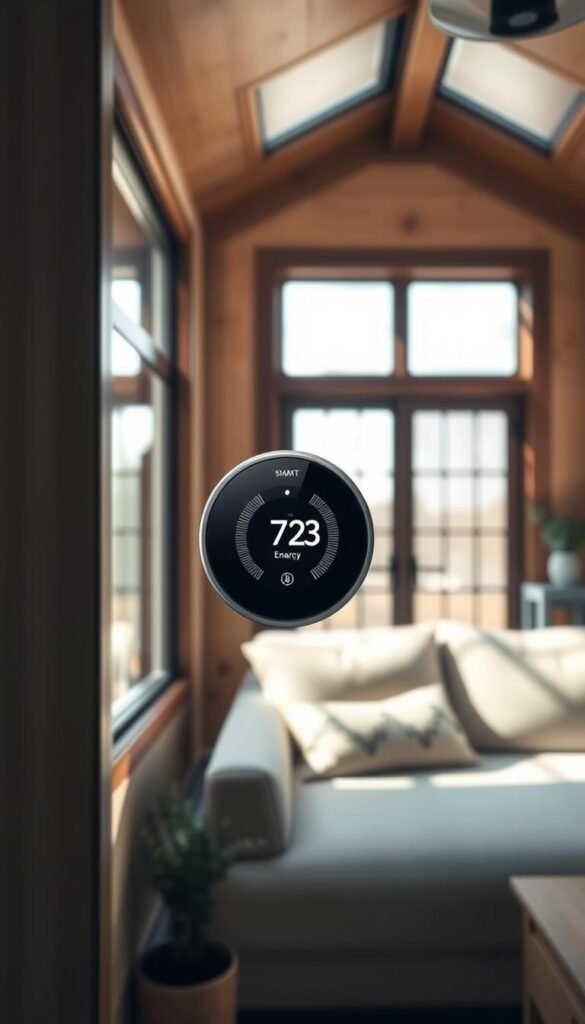
Integrating Smart Thermostats
Programmable devices optimize heating cooling systems through automated adjustments. Unlike manual controls, these units learn occupancy patterns and adjust temperatures before residents notice discomfort. A 7-day schedule can lower energy use by 10-12% according to EPA studies.
Nighttime settings demonstrate their value. Smart models gradually reduce heating during sleep hours, then warm spaces before morning alarms. This approach prevents system overwork while maintaining consistent comfort levels.
Renewable Energy Integration for Off-Grid Living
Solar panels slash reliance on traditional power grids. A 400W system can fully support a tiny home’s climate needs in sunny regions. Battery banks store excess energy for nighttime use, creating self-sufficient temperature management.
| Feature | Smart Thermostat | Traditional Model |
|---|---|---|
| Energy Savings | 15-23% | 0-5% |
| Remote Control | Yes | No |
| Learning Capability | AI-powered | Manual Only |
Combining solar power with efficient equipment yields dramatic savings. Homeowners report $300-$600 annual reductions in utility costs. Federal tax credits covering 30% of installation expenses improve affordability for eco-conscious buyers.
Return on investment calculations should consider local climate and energy rates. Southern states often recoup solar costs in 6-8 years, while northern regions may take 9-12. Proper planning ensures upgrades deliver both environmental benefits and financial returns.
Insulation, Ventilation, and Seasonal Temperature Management
Maintaining comfort in compact dwellings hinges on two critical factors: insulation quality and airflow control. Strategic material choices and seasonal adjustments create stable environments while minimizing energy waste.
Improving Insulation in Compact Spaces
Tiny homes demand innovative insulation approaches. Space constraints often force builders to use thin yet high-performance materials like aerogel or vacuum panels. Mobile units require extra attention – road vibrations can loosen seals over time.
Skirting installations prove essential for raised structures. These barriers prevent cold air infiltration underneath floors, reducing heating cooling demands by up to 15%. Thermal windows with argon gas fillings outperform single-pane alternatives, blocking 50% more heat transfer.
Adjusting for Seasonal Fluctuations
Climate shifts require proactive maintenance. Inspect window seals and door gaskets before extreme weather hits. Use caulk or weatherstripping to address new gaps in mobile units after relocation.
Proper ventilation balances moisture control and efficiency. Energy recovery ventilators provide fresh air without drastic temperature changes. Rotate ceiling fan directions seasonally – clockwise in winter pushes warm air downward, counter-clockwise in summer creates cooling breezes.
These targeted strategies help maintain comfortable tiny home environments year-round. Combining robust insulation with smart seasonal practices ensures efficient temperature regulation across changing weather patterns.



